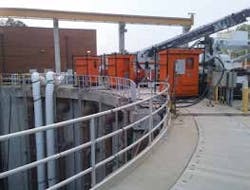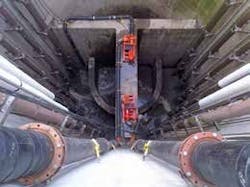Xylem Pairs Godwin and Flygt Pumps to Assist with Emergency Tunnel Project
Project
The city of Atlanta faced a critical problem in 2013 when the city’s Nancy Creek Tunnel failed due to years of sediment buildup. The tunnel is an 8-mile-long system that runs under northwest Atlanta, built to increase sewer capacity and handle storm water during heavy rains. The tunnel ends at the Nancy Creek Tunnel Lift Station, which pumps the wastewater to the treatment plant above it. With heavy rains on the way at the time, the city faced potential violations and large fines from the U.S. Environmental Protection Agency if the tunnel could not handle the extra flow.
“The city of Atlanta was really in a predicament,” said Shane Rutledge, Superintendent for Western Summit Constructors, Inc. “The pumps were failing, and the city was really afraid that it was going to [overload] a sewage field upstream.”
The city needed an innovative and efficient solution to manage flow in the tunnel so the sediment could be cleaned out and the damaged pumps fixed. Western Summit Constructors was chosen for the project, and Rutledge subsequently chose to partner with Xylem for their Godwin brand of pumps. “I didn’t hesitate about contacting [Xylem],” Rutledge said. “When we have used other pump contractors, they say they’ll have a pump there in a day, and then it might be three or four days. Or the fusion equipment doesn’t work when it’s on site. In my 16 years of experience, I have vetted out Godwin pumps to be the best to use.”
Solution
To pump the water out of the 160-ft-deep Nancy Creek Tunnel, Xylem designed a dual pumping system that joined two Flygt 3000 series wastewater pumps and two Godwin CD300M Dri-Prime pumps with variable-frequency drive (VFD) controls. The pumps discharged out of the station using 18-in. HDPE pipe. Sections of HDPE pipe were lowered and fastened to the station walls while the Xylem fusion team fabricated intricate sections of pipe to complete the system.
Because the project was a temporary application, the city of Atlanta chose to rent the pumps from Xylem. Both Flygt and Godwin were selected to accomplish the job, with the submersible Flygt pumps used for their high-head capability and centrifugal Godwin pumps specified for their long discharge lengths, according to Jay Andrade, Senior Sales Engineer for Xylem. Xylem designed a system that placed the Flygt pumps on the sloped tunnel floor while the Godwin pumps were set on a “Tee” wall about halfway down. That way, the submersible pumps could pump the water halfway (80 ft), and the centrifugal pumps could boost the water and pump it out of the hole.
With Xylem designing the system and Western Summit installing it, both companies relied on strong communication and teamwork with one another to get the project done correctly. Xylem provided the equipment and assisted in the setup and labor, Andrade said. Western Summit provided the labor and assisted with setup and design. “We thought through the process and what we could do to get the water out of this system,” Rutledge said. “It was a really unique collaboration. Both teams complemented each other.” “The manpower was readily available, and the fusion equipment was at the site when needed,” Rutledge said. “Our collaboration really worked well. During the planning phase when we had to change the system a little to make it more efficient, they were really receptive to my idea of relocating the location of the pumps on the wall.”
Strong communication was crucial as the Western Summit team installing the system below grade relayed measurements to the Xylem fusion team above ground. The fusion team would then weld a piece to the desired specifications and send it down to the Western Summit crew to install. “There was very little room for error; there were just inches of play in some of these spots,” Andrade said.
Results
Xylem’s pump solution was installed under Western Summit’s leadership in a matter of days. Work on the overall project took just over a month. The pumping solution allowed Western Summit to quickly move to the next phase of emergency work to remove debris and install the repaired pumps for the pump station. “It was very successful, and the overall operation kept the city from surcharging upstream,” Rutledge said. “The city of Atlanta was very happy with both Western Summit and [Xylem].”
Editor's Note: Scranton Gillette Communications and the SGC Water Group are not liable for the accuracy, efficacy and validity of the claims made in this piece. The views expressed in this content do not reflect the position of the editorial teams of Water & Wastes Digest, Water Quality Products and Storm Water Solutions.

